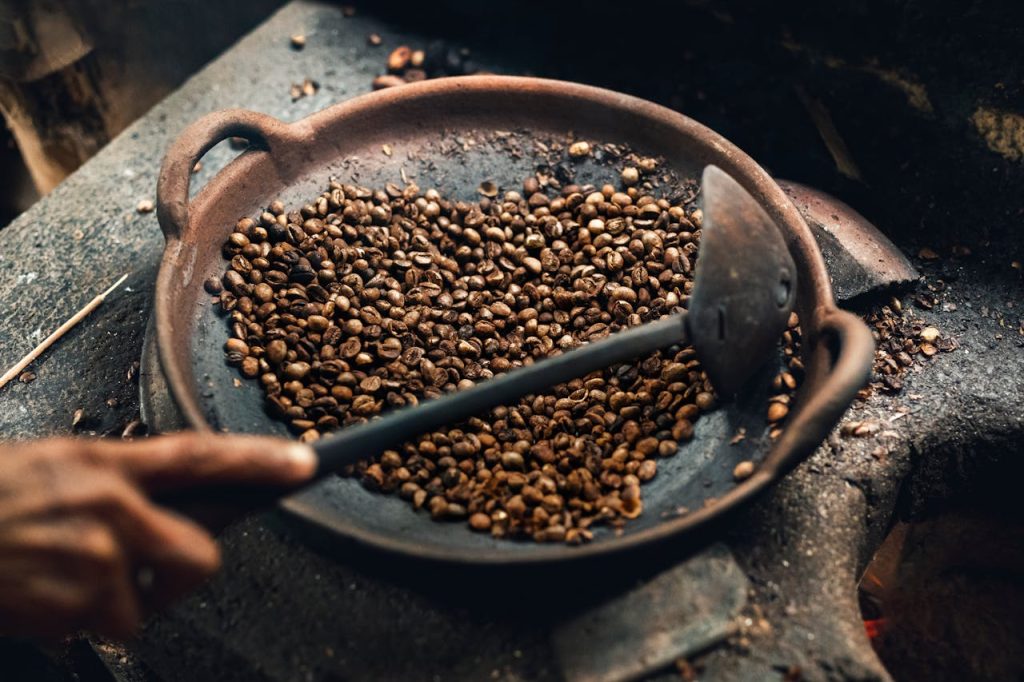Roasting coffee beans at home advantages you in taking part in freshly roasted espresso with a robust flavor. While coffee from stores is available, roasting your beans gives you greater freshness, strong aroma and overall management over the roast level.
Coffee beans are uncooked and do not scent like a sturdy coffee fragrance. Roasting coffee beans transforms them into the brown-scenting beans that we drink. Heat activates sophisticated chemical reactions, consisting of caramelizing, that create the flavors in an ideal cup of espresso.
Whether you’re a newbie or a pro coffee lover, this book walks you through the complete roasting machine with different techniques, roasting instances, and crucial hints for purchasing great results.
How the Coffee Roasting Process Works
Coffee bean roasting is a process of revealing uncooked, green espresso beans to warmness to free up their taste and aroma. The manner can be classified into essential levels:
- Drying Phase: Coffee beans comprise moisture that needs to be evaporated. This section lasts for approximately 4 mins at temperatures among three hundred-320°F (a hundred and fifty-a 100 and 60°C).
- Browning Phase: As the beans preserve heat, they flip from inexperienced to yellow, after which they brown. This degree enhances acidity and aroma.
- First Crack: Around 385-a 100°F (196-205°C), the beans increase and crack loudly. This is the spoil from a moderate roast to a medium roast.
- Development Phase: Depending on the roast diploma desired, beans may be roasted in addition. The 2d crack occurs at barely excessive temperatures, ensuing darker roasts.
- Cooling Phase: Once beans reap the favored roast level, they need to be cooled quickly to avoid cooking further.
How to Roast Coffee Beans at Home
There are numerous methods to roast coffee beans at home, based totally on the gear you’ve got available.
Roasting Espresso Beans in an Oven
Oven-roasting coffee beans is one of the maximum reachable strategies, but pay close attention not to chop-roast.
Instructions:
- Set your oven to 450°F (232°C).
- Place a thin layer of inexperienced espresso beans on a perforated baking sheet so that the warmth is sent lightly.
- Place the tray inside the oven and stir the beans little by little, even as roasting.
- Listen to the primary crack around 10-15 mins. Remove for light roast or maintain roasting to darker kind.
- Cool the espresso beans by way of spreading them on a metal floor or with the help of a fan.
Pros: Simple approach and now not based on a unique gadget.
Cons: Frequent stirring and lack of even roasting.
Roasting Coffee Beans in a Stovetop Pan
A stovetop pan gives greater control over the roast but needs consistent stirring.
Steps:
- Preheat a heavy-bottomed skillet or solid iron pan to medium heat.
- Add a small quantity of inexperienced coffee beans and stir constantly to prevent burning.
- Watch the color alternate and pay attention to the primary spherical crack for five minutes.
- Continue roasting for darker roasts, or stop right away for a mild roast.
- Pour the beans into a metallic colander and shake to release extra chaff.
Advantages: Greater control over roasting, no extra system needed.
Disadvantages: Need to stir constantly and may produce smoke.
Roasting Coffee Beans in an Air Popcorn Popper
An air popcorn popper is another home roaster preferred because it employs air to flow calmly into a regular roast.
Steps:
- Heat the popcorn popper for 30 seconds.
- Put inexperienced coffee beans (no longer extra than 1/2 of a cup) to save you overflow.
- Allow the beans to become round gently and show interest in the first spherical crack for three to five minutes.
- Stop roasting at the same time as the beans reach your preferred level.
- Pour the beans well right into a colander and shake to chill them down rapidly.
Pros: Even roasting with less attempt.
Cons: Only suitable for small batches.
Home Roasting of Coffee Beans
A home coffee roaster permits accurate temperature and roast degree control.
Procedure:
- Set the desired roast temperature and time based on your selected roast stage.
- Kindly insert the uncooked espresso beans and permit the equipment to paintings its magic.
- Hear the first and second cracks and determine at the same time as fending off over-roasting.
- Chill the beans through the roaster’s built-in cooling system or an outside colander.
Pros: Consistent results with little experimentation.
Cons: Anticipate funding in strong point equipment.
Different Roast Levels and Descriptions
The diploma of roasting varies in line with the very last flavor of your coffee.
- Light Roast: Preserves more acidity and fruity notes. Suited for pour-over and easy-out espresso.
- Medium Roast: Chocolate and caramel undertones balanced flavor. Ideal for espresso and drip coffee.
- Dark Roast: Bold, smoky flavor with low acidity. Ideal for French press and coffee-based total beverages.
Cooling and Storing Roasted Coffee Beans
Once roasting is complete, you need to chill the beans rapidly so that you do not end up overcooking. Dry them out on a much-out floor or use a blower to hurry the process up. Once cooled down, allow the beans to rest for at least 12-24 hours to enable degassing, which enhances the flavor.
Buy the best quality coffee beans from a reputable organic Robusta coffee bean supplier, for high-quality products. Store roasted espresso beans in a hermetic location free from a hint of warmness and moisture. Don’t store them in the refrigerator, wherein condensation can wreck the taste.
Conclusion
Home roasting espresso beans is a simple and profitable method that permits you to have bubbly, flavoring espresso with entire flexibility in roast stages. Regardless of whether you use an oven, stovetop skillet, popcorn popper, or a home roaster, the secrets to test and find out what works pleasant to your flavor.
One of the major factors before purchasing coffee beans is to consider highly recommended organic Robusta coffee beans distributors. Visit our website to find the best quality coffee beans at wholesale rates.
By choosing tremendous uncooked beans, tracking roasting times, and the use of proper storage approaches, you’re able to take your coffee to a new degree. Try roasting your beans and enjoy the extreme aroma of freshly brewed coffee like never before.



